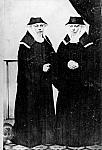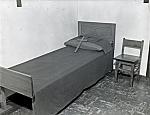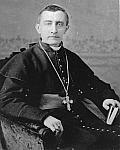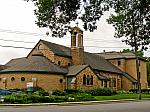
Ashes to Masses: The Discalced Carmelite Order of Grand Rapids
by Whitney Belprez
published: March 18th, 2011
As the empires and kingdoms of the Old-World Order crumbled and faded into the footnotes of history in the last days of the turbulent nineteenth century, the dawning of the twentieth century brought new hopes and ideas for a more democratic and egalitarian future. New philosophies and political ideologies that had previously been divisive and controversial became widespread and manifested in multiple revolutions around the world. From the fires of one such coup d’état in Mexico, emerged a band of refugee nuns whose resettlement in the diocese of Grand Rapids, Michigan, resulted in the establishment of the Discalced Carmelite Order of Our Lady of Guadeloupe. Led by their prioress Mother Mary Elias, and aided by the generosity of Grand Rapids Catholics, the Carmelite’s settlement marked a pattern of immigration that continues to characterize West Michigan. (Find more information to your right in Related Items)
In 1910, Francisco Madero, a Mexican revolutionary, declared war on Mexican President Porfirio Diaz; and, in the same year, Carmelite Sister Mary Elias became Mother Mary Elias of the Blessed Sacrament when she was named prioress of her San Jose, Mexico monastery. By 1916, persecution of priests, nuns and prominent Catholic laity had reached an intense climax in Mexico, as authorities routinely arrested, imprisoned, tortured, taxed, and murder members of the Church. An order came from the Vicar General of Mexico to Mother Mary Elias to dissolve her monastery and flee the bloody civil wars that had begun with Madero's revolution and would continue through 1920. After finding temporary solace in Havana, Cuba, New Orleans and St. Louis, the Carmelite sisters, led by Mother Mary Elias, were invited by Bishop Henry Joseph Richter to establish their community in the diocese of Grand Rapids.
On February 2, 1916, the Carmelite Order of Our Lady of Guadeloupe was founded in the city, and its establishment was marked by a mass with the Bishop. The nuns lived in an empty private home on the corner of Lafayette Avenue and Sycamore Street for two years until another suitable residence could be found. In 1918, a new site on Valley Avenue was suggested by the Sisters of the Good Shepherd, whose own home was across the street at Villa Maria. The community of Catholic sisters in the city provided aid to these new nuns in the diocese, including equipment and materials for their new trade-- making the Altar breads and vestments for the entire diocese. Since the nuns were cloistered, these tasks perfectly suited the Carmelites because they were not permitted beyond the walls of the monastery.
Prior to the arrival of the Mexican Carmelite sisters, waves of German and Irish immigration significantly impacted the diocese of Grand Rapids in the 1890s. Among these new Americans was Bishop Henry Richter, who immigrated to the United States from Germany at the age of sixteen, and later became a crucial ally to Mother Mary Elias and the local Carmelite order. More immigrants from Lithuania and Italy boosted Catholic numbers in West Michigan, and the settlement of the Carmelite nuns was an early indication of the next Catholic population surge from Latin America. At the time of the sisters' relocation to the city, few clergy spoke Spanish; today, thirteen parishes in the dioceses offer at least one Spanish Mass every weekend.
In 1941, construction on the Carmelite sisters' third monastery was completed, and an open house was held for the public in honor of the new building. The site was the same as the 1036 Valley Avenue monastery, though the entrance changed the address to 1256 Walker Avenue. Approximately 20,000 visitors walked through the new cloister from August 1 to August 15, 1941, and the Order's rules were temporarily relaxed to allow the Carmelite nuns to meet and interact with members of the community. The new chapel was dedicated to St. John of the Cross and St. Theresa of Jesus, a French Carmelite nun who had died around the time of the Order's escape from Mexico.
The Carmelite Order of Our Lady of Guadeloupe remained at the 1256 Walker Avenue monastery until 1991, when they moved to Ada Township, near St. Patrick's parish, and they continue to live an austere and rigorous lifestyle, today. The former Walker Avenue monastery was purchased by the Hope Network and now serves as the organization's Family Life Center. The enclosed yard, which for fifty years served as the only outdoor area for the Carmelites, recently opened as the Hope Network's Living Garden, a place of healing for patients and family members. The garden is still reminiscent of its former life as a monastery as ivy climbs the walls and gates, sheltering the statue of the Virgin Mary from outside eyes. The first community event held in the garden was a rosary, prayed on the ground the sisters walked for fifty years.

In 1916, Mother Mary Elias and her Carmelite Sisters, were forced to flee the bloody Civil War happening in Mexico. After living in Havana, Cuba; New Orleans, Louisiana; and St. Louis, Missouri; Bishop Henry Joseph Richter invited Mother Mary Elias and her sisters to live in Grand Rapids. The Nuns enjoyed a simple life, spending most of the day in silence.
Bibliography
Books Available at the Grand Rapids Public Library
- Ancona, Gaspar F. Where the Star Came to Rest: Stories of the Catholic People in West Michigan. France: Editions du Signe, 2001.
- Lydens, Z.Z. ed. The Story of Grand Rapids. Grand Rapids, Mich.: Kregel Publications, 1966.
Items Available at the History & Special Collections Dept. of the GR Public Library
- Grand Rapids Press, 26 July 1941. "Carmelite Nuns Here to Hold Open House in New Monastery." Churches: Catholic, Vertical File
- Grand Rapids Press, 28 February 1943. “Mother Mary Elias, Founder of Nuns’ Monastery Here, Dies.” Churches: Catholic, Vertical File
- Kerns, Marguerite S. “World of Peace is Seen by Visitors at Convent.” Grand Rapids Herald, 3 August 1941, Churches: Catholic, Vertical File,
- Lydens, Z.Z. ed. The Story of Grand Rapids. Grand Rapids, Mich.: Kregel Publications, 1966.
- McGee, John. The Catholic Church in the Grand River Valley 1833-1950. Lansing, Mich.: Franklin DeKleine Co., 1950.
Websites
- Carmelite Nuns of Ada (Parnell) Michigan
- Roman Catholic Diocese of Grand Rapids
- Order of Discalced Carmelites, General House of the Teresian Carmel






 facebook
facebook
